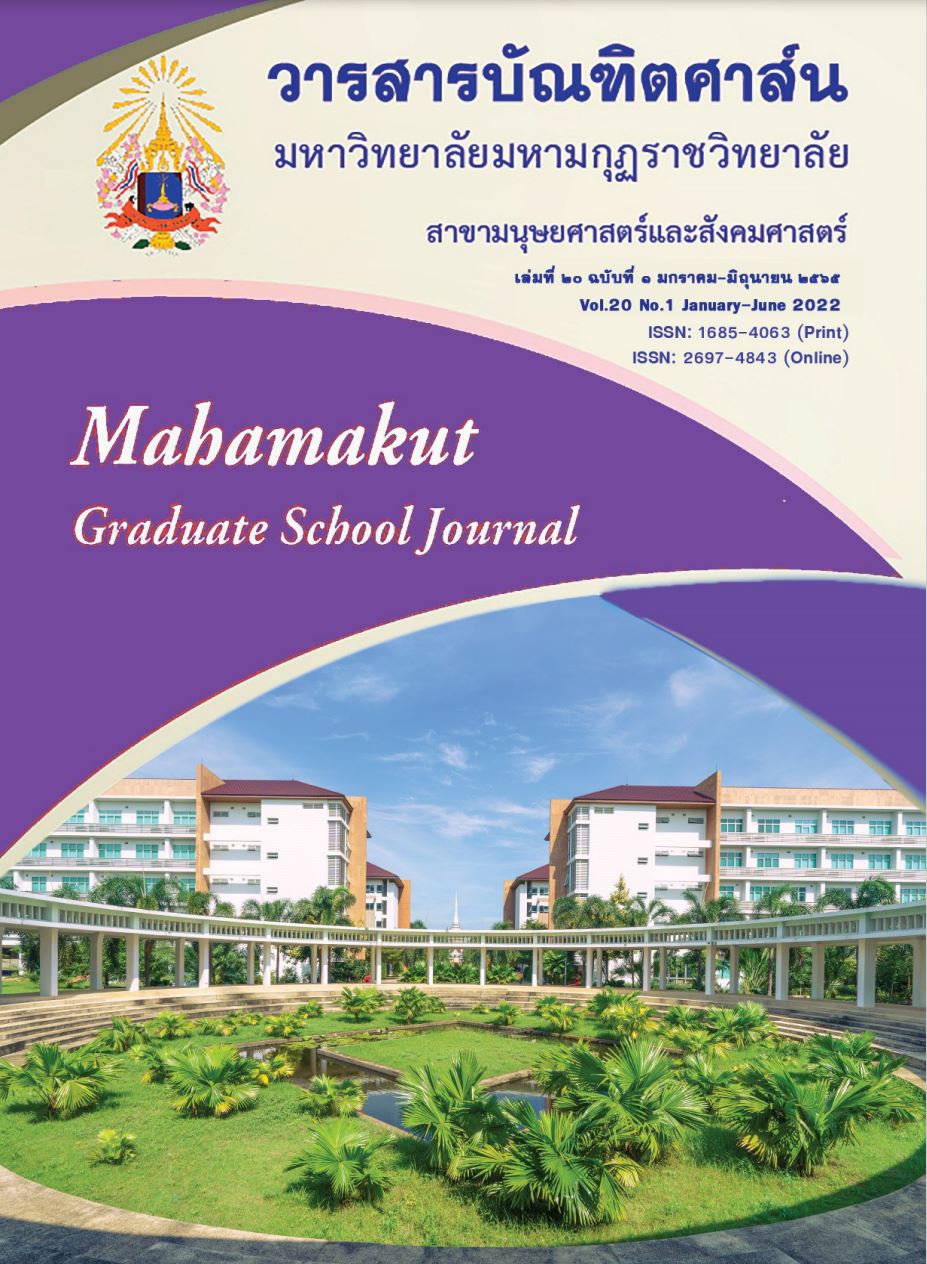โมเดลสมการโครงสร้างภาวะผู้นำเชิงคุณธรรมจริยธรรมแบบพุทธ ของผู้บริหารในมหาวิทยาลัยมหามกุฏราชวิทยาลัย
คำสำคัญ:
โมเดลสมการโครงสร้าง, ภาวะผู้นำเชิงคุณธรรมจริยธรรมแบบพุทธ, ผู้บริหารมหาวิทยาลัยมหามกุฏราชวิทยาลัยบทคัดย่อ
การวิจัยครั้งนี้มีวัตถุประสงค์เพื่อ 1) ศึกษาและเปรียบเทียบระดับการแสดงออกภาวะผู้นำเชิงคุณธรรมจริยธรรมแบบพุทธของผู้บริหารในมหาวิทยาลัยมหามกุฏราชวิทยาลัย 2) ศึกษาและเปรียบเทียบระดับการแสดงออกในปัจจัยที่มีอิทธิพลต่อภาวะผู้นำเชิงคุณธรรมจริยธรรมแบบพุทธของผู้บริหารในมหาวิทยาลัยมหามกุฏราชวิทยาลัย 3) ตรวจสอบความสอดคล้องของโมเดลสมการโครงสร้างภาวะผู้นำเชิงคุณธรรมจริยธรรมแบบพุทธของผู้บริหารในมหาวิทยาลัยมหามกุฏราชวิทยาลัย ที่พัฒนาขึ้นกับข้อมูลเชิงประจักษ์ และ 4) ศึกษาขนาดอิทธิพลของปัจจัยเชิงสาเหตุที่มีต่อภาวะผู้นำเชิงคุณธรรมจริยธรรมแบบพุทธของผู้บริหารในมหาวิทยาลัยมหามกุฏราชวิทยาลัย โดยใช้วิธีการวิจัยเชิงปริมาณ (Quantitative research) กลุ่มตัวอย่างที่ให้ข้อมูล เป็นผู้บริหาร คณาจารย์ และเจ้าหน้าที่ สังกัดมหาวิทยาลัยมหามกุฏราชวิทยาลัย จำนวน 434 รูป/คน ได้มาโดยวิธีการสุ่มอย่างง่าย (Simple random sampling) เครื่องมือที่ใช้ในการวิจัยเป็นแบบสอบถามชนิดมาตรวัดประเมินค่าระดับการแสดงออกภาวะผู้นำเชิงคุณธรรมจริยธรรมแบบพุทธและปัจจัยเชิงสาเหตุที่มีค่าความเชื่อมั่น 0.97 และ 0.98 ตามลำดับ สถิติที่ใช้วิเคราะห์ข้อมูลเป็นสถิติเชิงพรรณนาและสถิติเชิงอ้างอิง โดยวิเคราะห์ด้วยโปรแกรมสำเร็จรูปทางสถิติและโปรแกรม LISREL
ผลการวิจัย พบว่า
- ระดับการแสดงออกภาวะผู้นำเชิงคุณธรรมจริยธรรมแบบพุทธของผู้บริหารในมหาวิทยาลัยมหามกุฏราชวิทยาลัยโดยภาพรวม พบว่า มีค่าเฉลี่ย อยู่ในระดับมาก เมื่อวิเคราะห์เปรียบเทียบจำแนกตามสถานภาพ
ของผู้ตอบแบบสอบถาม พบว่า ผู้บริหารมีระดับการแสดงออกภาวะผู้นำเชิงคุณธรรมจริยธรรมแบบพุทธไม่แตกต่างกัน ยกเว้นสถานภาพด้านช่วงอายุไม่เกิน 35 ปี กับ 46 ปีขึ้นไป พบว่า ผู้บริหารมีระดับการแสดงออกภาวะผู้นำเชิงคุณธรรมจริยธรรมแบบพุทธแตกต่างกัน อย่างมีนัยสำคัญทางสถิติที่ระดับ 0.05
- ระดับการแสดงออกในปัจจัยที่มีอิทธิพลต่อภาวะผู้นำเชิงคุณธรรมจริยธรรมแบบพุทธของผู้บริหารในมหาวิทยาลัยมหามกุฏราชวิทยาลัย โดยภาพรวม พบว่า ผู้บริหารมีระดับการแสดงออกในปัจจัยเบญจธรรม อิทธิบาท และมยปัญญา อยู่ในระดับมาก เมื่อวิเคราะห์เปรียบเทียบจำแนกตามสถานภาพของผู้ตอบแบบสอบถาม พบว่า ผู้บริหารมีระดับการแสดงออกในปัจจัยที่มีอิทธิพลต่อภาวะผู้นำเชิงคุณธรรมจริยธรรมแบบพุทธไม่แตกต่างกัน ยกเว้นสถานภาพด้านช่วงอายุไม่เกิน 35 ปี กับ 46 ปีขึ้นไป พบว่า ผู้บริหารมีระดับการแสดงออกในปัจจัยเบญจธรรม อิทธิบาท และมยปัญญา แตกต่างกัน อย่างมีนัยสำคัญทางสถิติที่ระดับ 0.05
- โมเดลสมการโครงสร้างภาวะผู้นำเชิงคุณธรรมจริยธรรมแบบพุทธที่ผู้วิจัยพัฒนาขึ้น มีความสอดคล้องกับข้อมูลเชิงประจักษ์ โดยมีค่าดัชนีวัดระดับความสอดคล้อง ได้แก่ P-value of , /df, GFI, AGFI, CFI, SRMR, RMSEA, CN และ LSR ผ่านเกณฑ์ตามที่กำหนดทุกค่า
4. ปัจจัยเบญจธรรมมีค่าอิทธิพลรวมสูงสุดต่อภาวะผู้นำเชิงคุณธรรมจริยธรรมแบบพุทธ เท่ากับ 0.93 อย่างมีนัยสำคัญทางสถิติที่ระดับ 0.01 โดยมีค่าอิทธิพลทางตรงต่ออิทธิบาท เท่ากับ 0.98 และมีค่าอิทธิพลทางอ้อมผ่านอิทธิบาทไปยังภาวะผู้นำเชิงคุณธรรมจริยธรรมแบบพุทธและมยปัญญา เท่ากับ 0.83 และ 0.94 ตามลำดับ อย่างมีนัยสำคัญทางสถิติที่ระดับ 0.01 รองลงมา คือ ปัจจัยอิทธิบาทมีค่าอิทธิพลรวมต่อภาวะผู้นำเชิงคุณธรรมจริยธรรมแบบพุทธ เท่ากับ 0.85 อย่างมีนัยสำคัญทางสถิติที่ระดับ 0.01 โดยมีค่าอิทธิพลทางตรงต่อมยปัญญาและภาวะผู้นำเชิงคุณธรรมจริยธรรมแบบพุทธเท่ากับ 0.96 และ 0.81 ตามลำดับ อย่างมีนัยสำคัญทางสถิติที่ระดับ 0.01 ส่วนปัจจัยมยปัญญาไม่มีค่าอิทธิพลต่อภาวะผู้นำเชิงคุณธรรมจริยธรรมแบบพุทธ ทั้งนี้ ปัจจัยเชิงสาเหตุทั้งสามตัวร่วมกันอธิบายภาวะผู้นำเชิงคุณธรรมจริยธรรมแบบพุทธ ได้ร้อยละ 0.96
เอกสารอ้างอิง
บุญเชิด ภิญโญอนันตพงษ์. (2545). การประเมินการเรียนรู้ที่เน้นผู้เรียนเป็นสำคัญ แนวคิดและวิธีการ. พิมพ์ครั้งที่ 2. กรุงเทพฯ บริษัท วัฒนาพานิช จำกัด.
ณัฐธนธีรา ศรีภา. (2563). โมเดลสมการโครงสร้างภาวะผู้นำเชิงคุณธรรมจริยธรรมแบบพุทธของผู้บริหารในมหาวิทยาลัยมหามกุฏราชวิทยาลัย. ดุษฎีนิพนธ์ศึกษาศาสตรดุษฎีบัณฑิต, สาขาวิชาการบริหารการศึกษา, บัณฑิตวิทยาลัย, มหาวิทยาลัยมหามกุฏราชวิทยาลัย.
นงลักษณ์ วิรัชชัย. (2542). โมเดลลิสเรล: สถิติวิเคราะห์สำหรับการวิจัย.พิมพ์ครั้งที่ 3. กรุงเทพฯ: โรงพิมพ์จุฬาลงกรณ์มหาวิทยาลัย.
มูลนิธิมหามกุฏราชวิทยาลัย. (2538). พระไตรปิฎกบาลี ฉบับสยามรัฐ เล่ม 27 กรุงเทพฯ: โรงพิมพ์มหามกุฏราชวิทยาลัย.
วรรณี แกมเกตุ. (2551). วิธีวิทยาการวิจัยทางสังคมศาสตร์. พิมพ์ครั้งที่ 2. กรุงเทพฯ: โรงพิมพ์แห่งจุฬาลงกรณ์มหาวิทยาลัย.
สมชาย วรกิจเกษมสกุล. (2554). ระเบียบวิธีการวิจัยทางพฤติกรรมศาสตร์และสังคมศาสตร์. อุดรธานี: อักษรศิลป์การพิมพ์.
สำนักงาน ป.ป.ช. (2560). ประกาศสำนักงาน ป.ป.ช. สืบค้นเมื่อ 15 ธันวาคม 2561, จาก https:// www.nacc.go.th/department/departmentin/center.
สุชาติ ประสิทธิ์รัฐสินธุ์. (2550). ระเบียบวิธีการวิจัยทางสังคมศาสตร์. พิมพ์ครั้งที่ 14. กรุงเทพฯ: ห้างหุ้นส่วนจำกัด สามลดา.
สุวิทย์ ภาณุจารี. (2562). การวิจัยทางการบริหารการศึกษา. กรุงเทพฯ: Jprint.
Best, John W. (1986). Research in Education. 5th ed. New Jersey: Prentice Hall, Inc.
Bollen, K.A. (1989). Structural Equations with Latent Variables. John Wiley and Sons, Inc., New York.
Diamantopoulos, Adamantios & Siguaw, Judy A. (2000). Introducing LISEL: A Guide for the. Unitiated. London: Sage.
Hair, J. F. Jr. Black, W. C., Babin, B. J. Anderson, R. E. and Tatham, R. L. (2006). Multivariate data analysis. 6th ed. New Jersey: Prentice Hall.
Jöreskog, K.G. & Sörbom, D. (1993). LISREL 8: Structural equation modeling with the SIMPLIS command language. Chicago, IL, US: Scientific Software International; Hillsdale, NJ, US: Lawrence Erlbaum Associates, Inc.
Kaplan, D. (2000). Structural equation modeling: Foundations and extensions. Thousand Oaks, CA: Sage.
Krejcie, R. V. & Morgan, D. W. (1970). Determining Sample Size for Research Activities. Educational and Psychological Measurement, 30(3), pp. 607-610.
Nunnally, J. C. (1978). Psychometric Theory. 2nd ed. New York: McGraw-Hill.
ดาวน์โหลด
เผยแพร่แล้ว
รูปแบบการอ้างอิง
ฉบับ
ประเภทบทความ
สัญญาอนุญาต
ลิขสิทธิ์ (c) 2022 มหาวิทยาลัยมหามกุฏราชวิทยาลัย

อนุญาตภายใต้เงื่อนไข Creative Commons Attribution-NonCommercial-NoDerivatives 4.0 International License.
บทความวิชาการและบทความวิจัยในวารสารฉบับนี้ถือเป็นความรับผิดชอบของผู้เขียนเท่านั้น บทความที่ได้รับการตีพิมพ์ในวารสารบัณฑิตศาส์น ถือเป็นลิขสิทธิ์ของมหาวิทยาลัยมหามกุฏราชวิทยาลัย ตามพระราชบัญญัติลิขสิทธิ์



